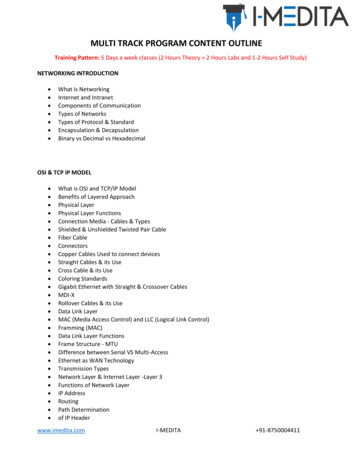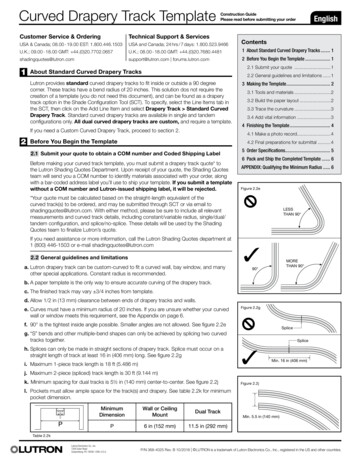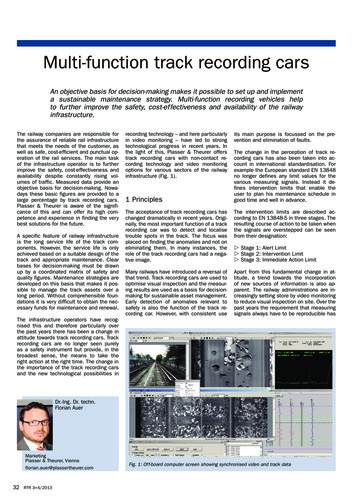
Transcription
MULTI TRACK PROGRAM CONTENT OUTLINETraining Pattern: 5 Days a week classes (2 Hours Theory 2 Hours Labs and 1-2 Hours Self Study)NETWORKING INTRODUCTION What is NetworkingInternet and IntranetComponents of CommunicationTypes of NetworksTypes of Protocol & StandardEncapsulation & DecapsulationBinary vs Decimal vs HexadecimalOSI & TCP IP MODEL What is OSI and TCP/IP ModelBenefits of Layered ApproachPhysical LayerPhysical Layer FunctionsConnection Media - Cables & TypesShielded & Unshielded Twisted Pair CableFiber CableConnectorsCopper Cables Used to connect devicesStraight Cables & its UseCross Cable & its UseColoring StandardsGigabit Ethernet with Straight & Crossover CablesMDI-XRollover Cables & its UseData Link LayerMAC (Media Access Control) and LLC (Logical Link Control)Framming (MAC)Data Link Layer FunctionsFrame Structure - MTUDifference between Serial VS Multi-AccessEthernet as WAN TechnologyTransmission TypesNetwork Layer & Internet Layer -Layer 3Functions of Network LayerIP AddressRoutingPath Determinationof IP Headerwww.imedita.comI-MEDITA 91-8750004411
Transport Layer - Layer 4TCP & UDP HeaderSegmentationMultiplexingMultiplexing using Port NumbersPort NumbersUDP WorkingConnection EstablishmentTCP 3-Way HandshakeError RecoveryFlow ControlOrder Data TransferWindowingSliding Window protocolFunction of Transport LayerDifference between TCP & UDPSession LayerPresentation LayerApplication LayerDomain Name System (DNS)Hyper Text Transfer Protocol (HTTP)HTTPSDynamic Host Configuration Protocols (DHCP)File Transfer Protocol (FTP)Trivial File Transfer Protocol (TFTP)Simple Mail Transfer Protocol (SMTP)Post Office Protocol (POPv2 & POPv3)Internet Message Access Protocol (IMAP)TelnetSecure Shell (SSH)Network Layer Protocol (NTP)Simple Network Management Protocol (SNMP)Secure SNMP or SNMPv3PDU (protocol data unit)IPv4 Addressing & SubnettingAssigning IP Network AddressesWhat is IPv4 AddressClasses of IPv4 AddressImportance of addresses in Real LifeIPv4 Address - Network ID & Host IDSubnet MaskSubnet Masks for different classes - Classful IP AddressingNetwork AddressBroadcast AddressHost Address or Host Assignable AddressDifference between Classful & Classless IP AddressingSubnettingwww.imedita.comI-MEDITA 91-8750004411
IP Subnetting MethodConcept of Public IP & Private IPRanges of Private IPTypes of IP Address Like Unicast, Multicast & BroadcastFixed Length Subnet MaskVariable Length Subnet MaskVLSM Subnet DesignSummarizationROUTER COMPONENTS & IOS BASICS What is RouterComponents & BootupRouter Boot up ProcessModes of RouterInitial Router ConfigurationPACKET FORWARDING What is RoutingAddress Resolution ProtocolRouting TableFunctions of Packet ForwardingPath Determination & Switching FunctionsROUTING PROTOCOL & FUNDAMENTALS Process of IP RoutingRouting Table SampleICMP PacketIPv4 & IPv6 HeaderEthernet FrameARP ProcessRouting ProcessOperational Planes of a RouterModes of Packet SwitchingProcess SwitchingFast SwitchingOperation of Cisco Express ForwardingLAB - PACKET FORWARDING CEF TableHow to Verify CEF SwitchingHow to Verify Adjacency Tablewww.imedita.comI-MEDITA 91-8750004411
How to Disable IP CEFIPv6 IPv6 - Why it is RequiredIPv6 FundamentalsIPv6 AddressesComparison of Header StructureTypes of IPv6 AddressLink-Local address CalculationsEUI -64Global Routing PrefixNeighbor Discovery Protocol (NDP)Duplicate Address Detection (DAD)Method to use & assign IPv6 addressesStatic IPv6 Address ConfigurationStateful DHCP for IPv6Stateless Address Autoconfigurationthe Prefix/Length & Default Router with NDP Router AdvertisementsLAB - IPv6 ADDRESSING Static IPv6 AddressStatic with EUI -64How to Enable IPv6 Unicast-RoutingHow to Verify IPv6 RoutesStateful DHCP - DHCPv6How to Verify Stateful DHCP in IPv6How to configure Stateless Autoconfiguration (SLAAC)How to configure Stateless Autoconfiguration with DHCPSTATIC ROUTING & RIPv2 What is Static RoutingRouting Information Protocol (RIP)Difference between RIPv1 & RIPv2RIP TimersRoute PoisoningPoison ReverseSplit HorizonConcept of Auto SummaryRIPngACCESS CONTROL LIST - ACL Access Control Listwww.imedita.comI-MEDITA 91-8750004411
types of Access-ListStandard Acccess ListWildcard Mask LogicStandard Access List ConfigurationACL Matching LogicACL using DirectionStandard Access-List CommandsExtended Access-ListCondition of Extended ACLName based ACLSequence Numbers in ACLNETWORK ADDRESS TRANSLATION Concept of Public IP & Private IP AddressRanges of Private IP AddressWhy NAT is RequiredWhat is NATStatic NATInside Local & Inside Global IP AddressOutside Local & Outside GlobalTopology for NAT LabsStatic NAT LabDynamic NATDynamic NAT LabPAT (Overload)PAT LabNAT Virtual Interface – NVIL2 TECHNOLOGIES Serial interfaceEncapsulation Protocols on Serial interfaceHDLC, PPP, Frame RelayEthernetPPP over EthernetPPPoE Client-Side ConfigurationDYNAMIC ROUTING Dynamic Routing Autonomous System Types of Routing Protocols IGP & Its Types Distance Vector Routing Protocols Link State Routing Protocols Enhanced Distance Vector Routing Protocolswww.imedita.comI-MEDITA 91-8750004411
EGP & Its TypesBGPMetricAdministrative DistanceAD & MetricRouter best routeConvergence TimeEIGRP - ENHANCED INTERIOR GATEWAY ROUTING PROTOCOL Concept of EIGRPEIGRP Neighborship and EIGRP Metric CalculationBandwidth, Load, Delay, Reliability & MTU.EIGRP Topology TableFD , RD , CD , Successor & FSEIGRP IP Routing TableEIGRP Packets - Hello , Update , ACK ,Query & ReplyEIGRP ConvergenceStuck in Active (EIGRP-SIA State)SIA Query & SIA Reply packetHow to limit the Scope of EIGRP Query DomainUnequal Metric Route Load SharingRoute Summarization in EIGRPAuto-SummaryManual-SummaryDefault-RouteEIGRP Neighborship on Frame RelayEIGRP Neighborship on MPLS VPNEIGRP Neighborship on Metro EthernetWAN Issues for EIGRP Topology ExchangeEIGRP for IPv6 Theory & ComparisonsConfiguration of EIGRP for IPv6What is Named EIGRPLAB - EIGRP LABS How to Enabling EIGRP AS 60346 in Private NetworkIPv6 Topology & LabConfiguration of Named EIGRP for IPv4OSPF-OPEN SHORTEST PATH FIRST OSPF Review and Design Concerns OSPF Tables Types of Network in OSPF Challenges in Multi - Access Networkwww.imedita.comI-MEDITA 91-8750004411
DR/BDR Election ProccessTypes of Routes in OSPFRules Concerning O & O IA RoutesOSPF Packets - Hello, DbD, LSR, LSU & LSAckStates of OSPF NeighborFundamental of LSAType - 1 LSA /Router LSAType - 2 LSA / Network LSAType - 3 LSA / Summary LSAVirtual - LinkNeed for Route RedistributionRedistributing in EIGRPRedistribution into OSPFRedistribution into OSPF - DefaultsType - 4 LSA / Summary - ASBR LSAType - 5 LSA / Extternal LSABest Path Selection in OSPFType - 6 LSA / Group Membership LSA for MOSPFTypes of Areas in OSPFType - 7 LSA / NSSA LSAFiltering redistributed Routes with Route MapsIssues with Multiple Redistribution PointsPrevent Routing Loops with Higher MetricsPrevent Routing Domain Loops with ADFiltering on Route Tag Using Distribute ListsManual SummarizationOSPFv3LAB - OSPF : LSA Initial ConfigurationsLSA details as per the labHow to Redistribute between EIGRP & OSPFTypes of Areas in OSPFDefault - Route in OSPFOSPv3 Topology Used in the LABLAB - ROUTE FILTERING TECHNIQUES Topology Used in LABHow to set AD 255How to Apply Access - ListHow to apply IP Prefix - ListApplication of Area Filter List in OSPFHow to apply Offset - List to set metric to infiniteFundamentals of Route - Mapwww.imedita.comI-MEDITA 91-8750004411
How to apply Route - Map using Distribute - ListHow to matching Metric Range in Route - MapHow to Matching ACL / Prefix - List in Route - MAPHow to use Route - Map in RedistributionBORDER GATEWAY PROTOCOL BGP ConceptsDifference between eBGP vs iBGPBGP Loop AvoidanceWhen we use & When we not to use BGPBGP Connection Types - Design TopologyBGP DatabaseBGP Routing ProcessBGP PacketsBGP Finite State Machine (FSM)IDLE StateCONNECT StateACTIVE StateOpenSent StateOpenConfirm StateEstablished StateBGP Configuration ConsiderationsPath AttributesCategories of BGP Path AttributesBGP Route Selection ProcessNext - HopWeightLocal PreferenceAS - PathOrigin CodeMEDFiltering BGP Routing UpdatesBGP CommunitiesBGP Regular Expression (RegEx)LAB - BGP LABS Configure BGP in LAB - Direct PeeringConfigure BGP in LAB - Indirect PeeringConfigure BGP Neighborship on LoopbacksBGP Route - ReflectorAuthentication between RoutersHow to clear the BGP SessionBGP Peer- GroupiBGP Synchronizationwww.imedita.comI-MEDITA 91-8750004411
Default Route in BGPBGP Address-FamilyAuto-Summary in BGPBGP Best Path ManipulationIPv6 Topology Used in the LABREMOTE SITE CONNECTIVITY VPN TechnologiesTunnel - Based Virtual Private NetworksGeneric Routing EncapsulationMultipoint GRE and NHRPNHRP Registration ProcessNHRP QueryProcessDynamic Multipoint VPNIPSec VPNIPSec Tunnel Establishment PhasesMPLSMPLS TerminologiesMPLS VPN - L3 VPN and L2 VPNLAB - VPN GRE ConfigurationConfiguration CommandsGRE verification CommandsDMVPN ConfigurationDMVPN Verification CommandsRouting Over DMVPNDMVPN Phase - 3VRF - LITE & PBR Easy Virtual NetworkingVRF - LiteVRF Routing TableWhat is Cisco EVNWhat is Route Replication in EVNWhat is Policy-Based RoutingAdditional Functions in PBRLAB - VRF - LITE & PBR Configurations of VRF - LiteVerification of VRF - LitePBR Lab TopologyConfiguration PBRwww.imedita.comI-MEDITA 91-8750004411
ROUTER SECURITY POLICY Password on the RouterStandard & Extended ACLTime Based ACLsInfrastructure ACLsuRPFAuthentication , Authorization , AccountingTACACS & RADIUSSNMP SecuritySNMPv2 & SNMPv2cSNMPv3Routing Protocol AuthenticationControl Plane PolicingIPv6 First Security FeaturesTroubleshooting Device ManagementIPv4 & IPv6 DHCPIP SLANetFlow AnalyzerCisco DNA AssuranceAssurance & AnalyticsBidirectional Forwarding Detection - BFDLAB - ELEMENTS OF A ROUTER SECURITY POLICY Topology Used in LABHow to Configure Password on the RouterHow to Configure Time Based ACLsIPv6 Traffic FilterHow to create SNMP View, Group & UserLAB - INFRASTRUCTURE SERVICES How to Configure DHCP in LABIP SLA LabNetFlow Analyzer LabSWITCHING TECHNOLOGIES Switching & Types of SwitchesLayer 2 and Layer 3 SwitchMultiLayer SwitchSwitchport TypesWhy we use "no switchport" Commandwww.imedita.comI-MEDITA 91-8750004411
DESIGNING CAMPUS AREA NETWORKS 3 Tier Hierarchical ModelAccess LayerDistribution LayerCore Layer2 Tier Hierarchical Model : Collapsed CoreFunctions of a Switch / Address LearningFilter & Forwarding DecisionsUnicast Address & Its TypesMulticast / Broadcast AddressLoop Avoidance with STPProcess of SwitchingMAC Address TableMultilayer SwitchingCisco Express ForwardingTCAM TableTCAM Forwarding DecisionsTCAM OperationsLayer - 3 / Multilayer Switch OperationVLAN, TRUNKING & INTER VLAN ROUTING Early Ethernet TechnologiesCSMA / CDCollision Domain and Broadcast DomainHow to make multiple broadcast domainVLAN ConceptsVLAN IDVLAN Assignment Method - Static VLAN & Dynamic VLANVLAN Deployment - End -to- End & LocalSwitchport ModesAccess PortsMulti Switch VLAN Without TrunkingConcept VLAN Tagging - Trunk PortCisco ISL (Inter Switch Link)IEEE 802.1qTypes of 802.1q Tag FormatInter VLAN routingRouter on a Stick MethodInter VLAN routing using - Layer 3 SwitchDTP and its ModesTrunk Negotiation using DTPVLAN TRUNKING PROTOCOLwww.imedita.comI-MEDITA 91-8750004411
What is VTPVTP Server, Client, Transparent and Off ModeDifference between VTPv1 & v2TPv3VTP CR Numbers & MD5 Digest ValueVTP MessagesSummary AdvertisementMD5 DigestSubset AdvertisementVTP Join/Prune messagesSTP- SPANNING TREE PROTOCOL STP ConceptsSTP VariationsSTP OperationsRoot Bridge Election Process using BPDUBPDU FormatFormat of TCN BPDUSTP Port CostSTP Port Roles - Root PortSTP TimersHow to manipulation Root BridgeSTP Port StatesDisabled , Blocking , Listening , Learning & ForwardingDesignated Port , Root Port & Non - Designated Port / Alternate PortElection Process of RP & DPSTP ConvergenceRP & DP ManipulationTypes of Topology Changes in STP - Insignificant, Direct and IndirectRapid Spanning TreeRSTP BPDU FormatRSTP Port StatesRSTP ConvergenceLink TypesMultiple STP / MSTPMST RegionSTP PROTECTION Root GuardLoop GuardBPDU GuardBPDU FilterUnidirectional Link Detection - UDLDEtherChannel Misconfiguration GuardEtherChannelwww.imedita.comI-MEDITA 91-8750004411
EtherChannel Load - BalancingPAgP & LACPLAYER 2 SECURITY Dynamic Host Configuration Protocol (DHCP)Rogue DHCP Server AttackDHCP StarvationDynamic ARP InspectionIP Source GuardPort SecurityStorm ControlPrivate VLANsProtected PortVLAN Access-ListWhat is Authentication, Authorization & AccountingDifference between RADIUS & TACACS SWITCHPORT ANALYZER Local SPANRemote SPANEncapsulated Remote SPANHIGH AVAILABILITY High AvailabilityHardware RedundancyStackWise & VSSVirtual Switching SystemSupervisor & Route Processor RedundancyRedundant Switch SupervisorsRedundancy Modes on Catalyst SwitchesConfigure the Redundancy ModeNonstop Forwarding - NSFEnable NSF in ProtocolsHost Standby Router ProtocolHSRP StatesVirtual Router Redundancy Protocol (VRRP)GLBP - Gateway Load Balancing ProtocolLoad Balancing Algorithm OptionsTwo types of Routers are electedHSRP , VRRP , & GLBPSWITCH MANAGEMENT SYSLOG NTPwww.imedita.comI-MEDITA 91-8750004411
CDPLLDPWIRELESS Types of Wireless Networks - WPAN, WLAN, WMANWireless LAN BasicsService Set (BSS) and BSS ConditionDistribution System & its ConditionsExtended Service Set & its ConditionIndependent Basic Service Set or Ad-hoc NetworkRepeaterWorkGroup BridgeOutdoor BridgeMesh NetworkRF SIGNALS & MODULATION Wireless ConceptsFrequency and Frequency SpectrumWireless LAN FrequenciesChannels in Band - 2.4 Ghz vs 5GhzAP & Wireless StandardsWIRELESS ARCHITECTURE Autonomous and Cloud-Based AP ArchitectureSplit-MAC Architectures & Its ConditionsCAPWAP - 2 TunnelsHow to connect CAPWAP Tunnels to Connect ApsWLC ActivitiesHow to deploy Unified Cloud WLCHow to deploy Embedded Mobility Express WLCCisco AP Modes & Its ConditionSECURING WIRELESS NETWORKS Anatomy of a Secure Connection Authenticating a Wireless Client and AP Message Privacy Message Integrity Wireless Client Authenticate Methods EAP Expansions LEAP - Lightweight EAP EAP - FAST PEAP EAP -TLS Wireless Privacy & Integrity Methodswww.imedita.comI-MEDITA 91-8750004411
WPA, WPA2 & WPA3Wireless Security MechanismsBUILDING OF WIRELESS LAN How to connect a Cisco APInitial Setup of a WLCHow to set your ControllerHow to access a Cisco WLCAccessing the Advanced Configuration InterfaceHow to configure GUI using Advanced WLCWLC PortsTypes of WLC PortsWLC InterfaceWLC Interface TypesUses of Virtual InterfaceHow to configuring a WLANHow to Configure a RADIUS ServerHow to create a Dynamic InterfaceHow to Create a New WLAN & Configuring WLAN SecurityHow to configuring Advanced WLAN SettingsHow to Finalizing WLAN ConfigurationQUALITY OF SERVICE What is QoSVoice over IP / Video Over IP PacketsQoS Classification & MarkingQoS ModelsQueuing StrategyPrioritization Strategy for Data , Voice & VideoPolicing & ShapingTraffic ShapingCongestion AvoidanceCONTROLLER BASED NETWORKING What is Network Automation Architectural Planes of the device Cisco Switch Data Plan Internals Controllers & Software-Defined Architecture Controller Placement in the Network Interfaces in Controller-Based Network What is API Interfaces in Controller-Based Network What is REST API Networks Programmability & SDN What is OpenFlowwww.imedita.comI-MEDITA 91-8750004411
OpenDaylight ControllerArchitecture of NBI , Controller Internals and SBI to Network DevicesCisoco SDN ControllerCisco Application Centric InfrastructureWhat is ACI Operating ModelApplication Policy Infrastructure ControllerUnderstanding ACI Data Center Control Using APICUnderstanding Cisco APIC Enterprise ModuleSummary of the SDN ExamplesBenefits of Controller Based NetworkingCISCO SOFTWARE DEFINED ACCESS What is Cisco Software-Defined AccessWhat is SDA UnderlaySDA Greenfield DesignAccess Layer Design - Traditional VS SDA FabricSDA OverlayVXLAN Tunnels in the Overlay (Data Plane)Principles of VXLANLocator Identity Separation Protocol (LISP)What is LISP MappingDNA Center & SDA OperationUnderstanding Cisco DNA CenterCisco DNA Center & Scalable GroupsSDA Security Based on User GroupsScalable Group Tag GridUnderstanding Cisco Prime Infrastructure (PI)DNA Center Differences with Traditional ManagementUNDERSTANDING REST & JSON Understanding RESTClient / Server ArchitectureStateless OperationBackground: Data & VariablesList & Dictionary VariablesREST APIs & HTTPSoftware CRUD Actions & HTTP VerbsUsing URIs with HTTP to Specify the ResourceData Serialization & JSONSerialization LanguagesInterpreting JSONMinified & Beautified JSONUNDERSTANDING ANSIBLE, PUPPET, & CHEFwww.imedita.comI-MEDITA 91-8750004411
Device Configuration ChallengesCentralized Configuration Files & Version ControlConfiguration of Monitoring & EnforcementConfiguration of ProvisioningConfiguration of Templates & VariablesFiles that Control Configuration AutomationUnderstanding AnsibleUnderstanding PuppetPuppet WorkingUnderstanding ChefComparison of Ansible , Puppet & ChefNETWORK SECURITY CONCEPTS Common security principlesUnderstanding confidentiality, integrity, availability (CIA)SIEM technologyCommon security termsCommon network security zonesCommon security threatsIdentify common network attacksUnderstanding social engineeringIdentify malwareClassify the vectors of data loss/exfiltrationCRYPTOGRAPHY CONCEPTS Understanding key exchangeUnderstanding hash algorithmUnderstanding symmetric and asymmetric encryptionDigital signatures, certificates, and PKISECURE ACCESS Secure managementUnderstanding in-band and out-of bandSecure network managementConfigure and verify secure access through SNMP v3 using an ACLConfigure and verify security for NTPUse SCP for file transferAAA CONCEPTS Understanding RADIUS and TACACS technologies Configure administrative access on a Cisco router using TACACS Verify connectivity on a Cisco router to a TACACS server Understanding Integration of Active Directory with AAAwww.imedita.comI-MEDITA 91-8750004411
Authentication and authorization using ACS and ISE802.1X authenticationIdentify the functions 802.1X componentsBYOD Understanding BYOD architecture frameworkFunction of mobile device management (MDM)VPN IPsec protocols and delivery modes (IKE, ESP, AH, tunnel mode, transport mode)hairpinning, split tunneling, always-on, NAT traversalRemote access VPNImplement basic clientless SSL VPN using ASDMVerify clientless connectionImplement basic AnyConnect SSL VPN using ASDMVerify AnyConnect connectionIdentify endpoint posture assessmentSite-to-site VPNImplement an IPsec site-to-site VPN with pre-shared key authentication on Cisco routers and ASAfirewallsVerify an IPsec site-to-site VPNSecure Routing and SwitchingSecurity on Cisco routersConfigure multiple privilege levelsConfigure Cisco IOS role-based CLI accessImplement Cisco IOS resilient configurationSECURING ROUTING PROTOCOLS Implement routing update authentication on OSPFSecuring the control planeFunction of control plane policingLayer 2 attacksSTP attacksARP spoofingMAC spoofingCAM table (MAC address table) overflowsCDP/LLDP reconnaissanceVLAN hoppingDHCP spoofingMitigation proceduresImplement DHCP snoopingImplement Dynamic ARP InspectionImplement port securityBPDU guard, root guard, loop guardwww.imedita.comI-MEDITA 91-8750004411
Verify mitigation proceduresVLAN securitySecurity implications of a PVLANSecurity implications of a native VLANFIREWALL TECHNOLOGIES Strengths and weaknesses of the different firewall technologiesProxy firewallsApplication firewallPersonal firewallCompare stateful vs. stateless firewallsOperationsFunction of the state tableImplement NAT on Cisco ASA 9.xStaticDynamicPATPolicy NATVerify NAT operationsImplement zone-based firewallZone to zoneSelf-ZoneFirewall features on the Cisco Adaptive Security Appliance (ASA) 9.xConfigure ASA access managementConfigure security access policiesConfigure Cisco ASA interface security levelsConfigure default Cisco Modular Policy Framework (MPF)Modes of deployment (routed firewall, transparent firewall)Methods of implementing high availabilityUnderstanding security contextsUnderstanding firewall servicesIPS- INTRUSION PREVENTION SYSTEM IPS deployment considerationsNetwork-based IPS vs. host-based IPSModes of deployment (inline, promiscuous - SPAN, tap)Placement (positioning of the IPS within the network)False positives, false negatives, true positives, true negativesUnderstanding IPS technologiesRules/signaturesDetection/signature enginesTrigger actions/responses (drop, reset, block, alert, monitor/log, shun)Blacklist (static and dynamic)CONTENT AND ENDPOINT SECURITYwww.imedita.comI-MEDITA 91-8750004411
Mitigation technology for email-based threatsSPAM filtering, anti-malware filtering, DLP, blacklisting, email encryptionUnderstanding mitigation technology for web-based threatsLocal and cloud-based web proxiesBlacklisting, URL filtering, malware scanning, URL categorization, web application filtering, TLS/SSLdecryptionUnderstanding mitigation technology for endpoint threatsAnti-virus/anti-malwarePersonal firewall/HIPSHardware/software encryption of local dataBelow mentioned Additional Modules (Will be provided based on companies Requirement). Student canopt for this learning based on his/her interest at No Extra Cost. Cyber Security and Ethical Hacking AWS-Cloud Computing Understanding Multivendor Firewall (Palo Alto, Checkpoint, Fortinet) Linux Essentials Microsoft Server Essentialswww.imedita.comI-MEDITA 91-8750004411
Bandwidth, Load, Delay, Reliability & MTU. EIGRP Topology Table FD , RD , CD , Successor & FS EIGRP IP Routing Table EIGRP Packets - Hello , Update , ACK ,Query & Reply EIGRP Convergence Stuck in Active (EIGRP-SIA State) SIA Query & SIA Reply packet How to limit the Scope of EIGRP Query Domain











